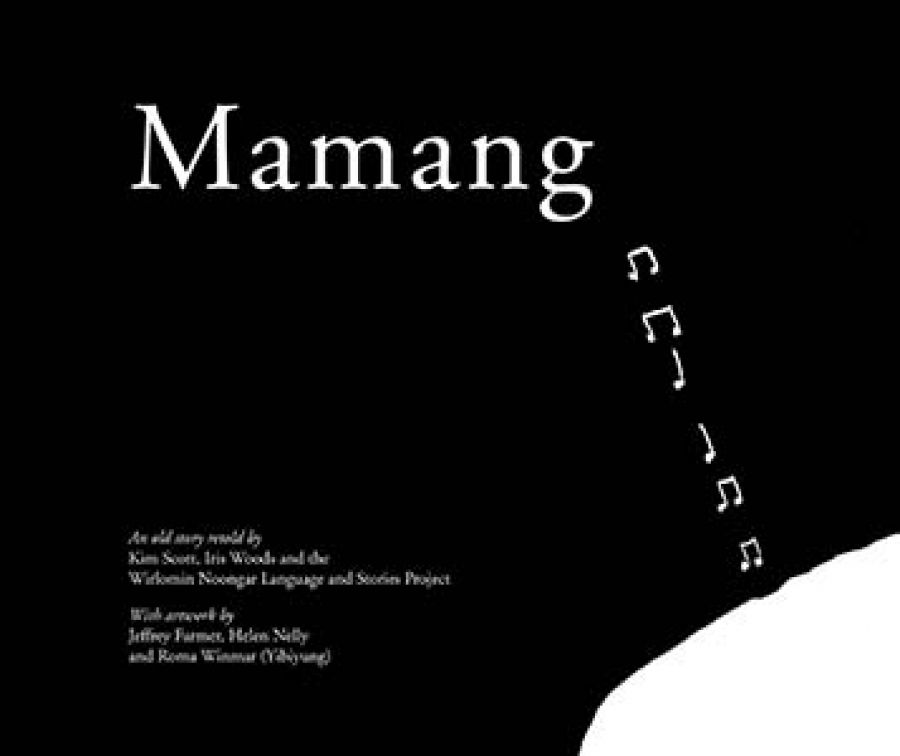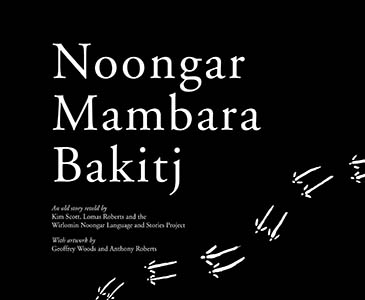
- Free Article: No
- Contents Category: Picture Books
- Review Article: Yes
- Online Only: No
- Custom Highlight Text:
Mamang and Noongar Mambara Bakitj are retellings of traditional Noongar narratives by the Miles Franklin Award-winning author Kim Scott, in collaboration with a team of others. The books are part of a broader Wirlomin Noongar Language and Stories reclamation and revitalisation project currently under way in the south-western coastal region of Western Australia, an area roughly traversing Albany to Esperance. Like many other Australian languages today, Noongar is barely hanging on. These modest diglot books, charmingly illustrated by Noongar people in simple, unaffected, and direct style, therefore represent a timely intervention into the continuing post-colonial destruction of this critically (and globally) endangered language.
- Book 1 Title: Mamang
- Book 1 Biblio: UWA Publishing, $24.95 pb, 36 pp
- Book 2 Title: Noongar Mambara Bakitj
- Book 2 Biblio: UWA Publishing, $24.95 pb, 44 pp
- Book 2 Cover Small (400 x 600):

- Book 2 Cover (800 x 1200):

- Book 2 Cover Path (no longer required): images/ABR_Digitising_2021/Sep_2021/Noongar_Mambara_Bakitj.jpg
Scott et al.’s contemporary versions of Mamang and Noongar Mambara Bakitj have been very loosely based on Noongar oral narratives told in 1931 to the German-American linguist Gerhardt Laves by Noongar speakers Freddie Winmer and Bob Roberts. Laves (1906–93) recorded and transcribed Winmer’s and Roberts’s accounts using the International Phonetic Alphabet, and also provided literal English translations. On his return to the United States, Laves took up a position at Chicago’s International Harvester Company, turning his back on linguistics for the remainder of his life, despite incontrovertible evidence of his aptitude in that field. It was not until the 1980s that Laves’s field notes were repatriated to Australia, where they have since been housed at the Australian Institute of Aboriginal and Torres Strait Islander Studies. More recently, Noongar descendants have turned to Laves’s manuscripts as springboards for the creation of their own contemporary English versions of the narratives collected some eighty years ago.
In their original form, the narratives speak to the proximity and interchangeability of the spirit world with the human world. Mamang is both creation narrative and an extended metaphor on the ontological changes wrought by male initiation, wherein a young man literally becomes one with his spirit ancestor, in this case a whale, the ‘mamang’ of the book’s title. Travelling through the ocean inside the whale, the young whale-man acquires detailed knowledge of the creature’s habitat and ethology, while developing a deep understanding of attendant ‘mamang’ ceremonies involving singing and dancing. After successfully meeting various challenges in the course of his epic journey, the young man is rewarded by marriage to two sisters who live in distant country, where the man eventually establishes a large family. As such, the narrative also offers a treatise on the requirement of exogamous marriage at alternate generational levels, traditionally a significant element of Noongar Law.
Noongar Mambara Bakitj, also containing some obvious references to male initiation practices, recounts an epic battle that occurs between a young man and spirit creatures, tricksters called ‘Mambara’. The young man inadvertently wanders into Mambara country where he hunts and kills kangaroos, without having sufficiently placated that country’s malevolent spirits of place. This narrative is about the severe penalties imposed upon those guilty of spatial transgressions, and also reveals the deep kinship that exists between members of the spirit world and ‘maparn’, ‘Clever Men’, or Aboriginal ‘men of high degree’ (to utilise A.P. Elkin’s terminology); that is, human men with sorcery powers, including the ability to fly, to restore severed or otherwise damaged or ‘dead’ limbs to their full strength, and to change shape or form at will. The young Noongar hero figure in this narrative is depicted in the process of metamorphosing into such a man.
Scott, in his preface to the 2011 versions of Mamang and Noongar Mambara Bakitj, describes them as having been‘inspired by’ the oral accounts that Laves had collected, transcribed, and translated in 1931. I must admit to having very mixed feelings about the books’ literary quality, particularly with respect to matters of voice and register, which, in both cases, are marked by considerable stylistic inconsistency. The language used fluctuates, in seemingly willy-nilly fashion, between contemporary, colloquial Aboriginal English terminology, and the elevated, poetic forms of expression that derive from direct translations of the original Noongar narratives. In both books, there are some lovely passages that capture the essence of the original texts: for example, ‘Deep down there in the dark inside the whale the man sang to the rhythm of the whale’s big slow heart beat until, slowly, the light came back’ (Mamang). But these are not sustained throughout.
It would seem that this stylistic patchiness has come about as a result of Mamang and Noongar Mambara Bakitj being ‘workshopped’ and co-authored by a group. (Imagine, for instance, if this had been the approach to translating Beowulf). Essentially comprising a committee of ‘stakeholders’, a small army of Noongar descendants of Roberts and Winmer worked with Scott on this text. The group also received advice from the linguist John Henderson. Unfortunately, the manner of assemblage shows in some parts of the books, which do not reflect the rhetorical quality of the original texts. I am not arguing for strictly literal translation. In these English versions, however, some of the beautiful, rhythmic cadences of the original Noongar texts have all but disappeared, particularly alliterative passages, consonance, and assonance.
Furthermore, the structures of Indigenous narratives work differently from English ones. While this is too large a subject to discuss here, I do not see why such difference should not be recognised in the approach taken, rather than striving to render these texts in ways that are virtually indistinguishable from the ways in which native speakers of English (mostly) structure narratives.
So, while Scott regards the process of bringing together archivally derived material and living Noongar descendants from various walks of life to decide on the content of these texts as ‘value-adding’, I am not so sure. Perhaps this enterprise would have been more successful had Scott been given an opportunity to work solo on the English versions. A distinctive politics of translation, based on a recently invented, bureaucratically inspired tradition of ‘Indigenous protocols’, seems to have intruded into this process, thereby compromising it. In the past (and today, in some parts of Aboriginal Australia), especially gifted individual narrators of Indigenous Dreaming narratives received social kudos, and were unproblematically singled out for special praise, lauded by their countrymen and women.
It is important, therefore, to distinguish between these books as acts or assertions of collective Noongar identity, and the books as literature, whether orally based or otherwise. With respect to the former, these books can be adjudged extremely successful. As Daniel Nettle and Suzanne Romaine put it in their book Vanishing Voices: The Extinction of the World’s Languages (2000): ‘A language is not a self-sustaining entity. It can only exist where there is a community to speak and transmit it.’ A language will almost certainly not survive without a critical mass of living speakers who are continuously shaping and, to some extent, remaking that language. For this reason, the publication of these books, and of any book using an Australian Indigenous language, is a significant event. On the other hand, surely reconciling these two goals – encouraging a broad base of living speakers of endangered Indigenous languages while simultaneously preserving and translating ‘high’ forms of oral Indigenous literature without needing to defer to a focus group – is not an impossible objective.


Comments powered by CComment